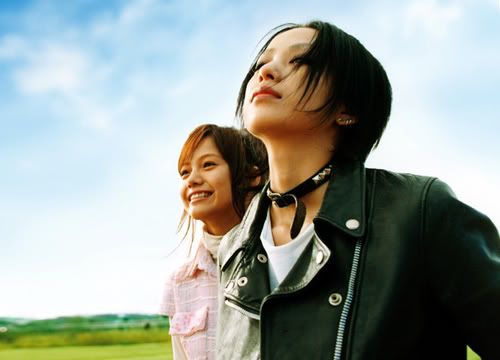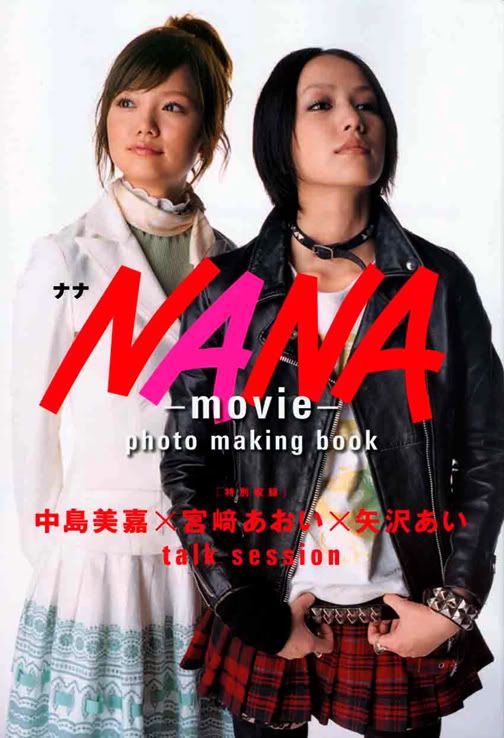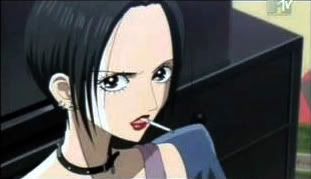 Nana vol. 1
Nana vol. 1Publisher: Shojo Beat/Viz Media
Writer/Artist: Yazawa Ai
English Adaptation: Allison Wolfe
Translation: Goto Koji
When my Nana
Stands next to your Nana
I can’t define Nana
When it’s not Nana
I’ve got two Nanas
I’ve got two Nanas
And they go tweet tweet tweet tweet tweet like little birds…
Yeah, I could’ve gone with something even lamer, like a David Letterman flopping at the Oscars riff: “Nana, meet Nana. Nana, Nana. Nana, Nana.” But no, I felt like breaking out some Talking Heads. It’s more appropriate.
My mental dysfunctions aside, I have gathered you here today, dearly beloved, to talk about Nana, the lively Japanese comic series where two young women both named Nana wind up cohabiting apartment 707 while chasing their dreams, living their lives and occasionally eating Jackson Burgers.
But before we get to all the fun stuff that makes up the actual story, we have to travel westward along the Tokkaido Line rails for volume 1, the two-part prelude where Nana Komatsu (eventually she’ll be known as Hachi, but for now she’s still just Nana K) has just graduated high school and broken up with her married boyfriend. Acting on the advice of her best friend Jun, this Nana decides to stop objectifying men. Good idea, because the result is something approximating true love with guy-pal Shoji. But how can it last when Jun, her laid-back boyfriend Kyosuke and Shoji are all moving to Tokyo to attend art college, with Nana stuck in their Podunk hometown?
In another city, another Nana is also being left behind. Lead singer of Blast (short for Black Stones), Nana Osaki has had a hard-luck life; not as bad as orphan Annie’s but still pretty rocky. She’s a high school dropout thanks to a trumped-up prostitution scandal, thinks she killed her grandmother and now her band is falling apart.
Despite sharing given names, the Nanas are definitely a study in contrasts. The first Nana is scatterbrained and immature, barely capable of making it through the day without falling madly and foolishly in love with some unwitting guy, forever exasperating the more together Jun with her silliness and seeming amorality. The other Nana is a Vivienne Westwood-loving rocker who hides her insecurity behind tough talk and an evil demeanor.
Writer/artist Yazawa Ai Yazawa gives each of her characters depths that become apparent as the story progresses. Nana K is flighty and immature, but also blisteringly self-aware and capable of personal growth. Nana O is tough and cynical, but also vulnerable. Even the supporting characters have a welcome richness. Best friend Jun is sensible but often frustrated with Nana, while Shoji shows flashes of a temper and a love of drinking that keep him from being merely the pretty boy love interest. And Kyosuke? It’s all good to him.
Yazawa’s artwork is quite appealing but not mindblowingly cute like something by Takahashi Rumiko. While it’s certainly not realism, it is fairly natural at times, even with those Japanese visual tropes- you know, stock depictions of facial expressions and emotions, the happiness face with half-circle eyes, no nose and a big triangular mouth. Lots of tone effects that have more meaning for Japanese readers than they do for ignorant me. Yazawa’s figures have spindly, elongated bodies that make them look fashionable, elegant even. They're romanticized, sophisticated.
Let's take a break and look at an image from the wildly popular Nana film adaptation, starring the exquisitely cast Nakashima Mika as Nana O, and the almost-as-well-cast Miyazaki Aoi as Nana K:
 Actually, they might be equally perfectly cast, but since the film isn't available here in Japan with English subtitles (you can order the region 1 DVD from Amazon.com, though), I haven't been able to see it. But from the publicity stills I've seen and the trailers I've watched, Nakashima looks as if she somehow stepped off Yazawa's drawing board directly into our world.
Actually, they might be equally perfectly cast, but since the film isn't available here in Japan with English subtitles (you can order the region 1 DVD from Amazon.com, though), I haven't been able to see it. But from the publicity stills I've seen and the trailers I've watched, Nakashima looks as if she somehow stepped off Yazawa's drawing board directly into our world.
Now, back to the review...
Backgrounds are sparse, and Yazawa relies heavily on dot-screened photos for outside environs, so occasionally the reader will recognize a real-world location, as in the scene where Nana K and Shoji walk through a neon-lit cityscape that could possibly be Shinjuku. The end result is even more focus on the characters. Which is fine, because Nana is such a character-driven narrative. What’s really interesting about the art is Yazawa’s mastery of costuming; I’m guessing the stretched fashion art figure work isn’t accidental. All her characters are very outfit-specific, from Nana K’s girly-girl late 90s combos complete with platform-soled shoes (the story opens in 1999, after all) to Nana O’s Vivienne Westwood gear.
Oh yeah, the movie version. It was such a huge hit the Japanese staff at my job were briefly Nanafied. I don't mean they dressed like Nana O. But during the film's initial run, their break room suddenly became absolutely littered with copies of Nana comics! In Japanese, of course. I mean, when The Dark Knight came out, did American offices suddenly disappear under an avalance of DC mags? I sincerely doubt it. Ah, Japan, where millions of people actually read comics and love them.
Here's a photo of a Nana movie photobook. When a movie comes out in Japan- much like in America- it's accompanied by tons of ancillary merchandise. My favorites are always the "making of" books, because they come loaded with photos:

Also, Japanese punk is somewhat different than Western punk, at least the modern iteration. To me, Nana O is more goth than punk, although she's heavy on the punk flourishes. Seems like a more purist punk would be a little less name-brand conscious. If anything, I’d put her more in the visual-kei subculture, further evidence of which is provided later in the series when her gosu-rori superfan Misato shows up. Visual-kei is a gothic pop/rock music style beloved by the gosu-rori tribe, and features androgynous or downright feminine-looking guys and… well… Nana-looking girls. Look up bands like Glay, L’Arc-en-Ciel and Dir en grey to see what I’m yakking about.
Still, if you were interested in dressing exactly like either Nana, Yazawa provides enough visual reference to make it easy. To turn yourself into Nana O, all you have to do is hit Hysteric Glamour or some of the other “punk” shops along Takeshita-dori in Harajuku where the Vivienne stuff is readily available; for Nana K, one of the suburban malls will do…
Actually, the Shitoro Aeon mall in my city of Hamamatsu would be perfect for any would-be Nana K’s out there. I could see her shopping there for looks to impress, outfits she thinks of as sophisticated or mature that end up showing just how naïve she really is about love and life in general.
Her hometown actually reminds me a lot of the first place I lived here in Japan, a small, blue collar city called Toyohashi, in Aichi prefecture- Japan’s industrial heartland, where the cyberpunk unreality of the Tokyo skyline is almost as foreign or distant as it is to your average American. In these places life is more workaday, less magical. Bisected by an ugly gash of train and shinkansen tracks, hugged to the north by mountains and to the south by the polluted Pacific, Toyohashi is a pleasant and unpretentious city of just plain folks (Japanese variety), the kind of place where cute but average girls like Nana K dream of escaping to a better life via marriage or work in Tokyo as a flight attendant or fashion store employee.
Hey, I forgot to tell you- not only did Nana inspire a hit film and its hit sequel, but also an animated series. As you can see from this still, the character design draws heavily on Yazawa's artwork. Fittingly so:

That Nana O has the characteristic Yazawa angular look. In the stylistic home of large eyes, Yazawa's are standouts. She imbues them with an emotive intensity not generally found in the work of other Japanese artists.
That was the final aside. I promise.
Although certain story clues seem to place Nana K’s little hometown as further north than Toyohashi, these smaller cities are pretty much the same, nowhere places lying along the shinkansen lines between somewhere places like Osaka and Tokyo. You see them flashing by, identical stations, McDonald’s and Jusco department stores.
You pass them by, hoping for a better life, a romantic dream come true… until you’re something of a Nana yourself.
Nana is compulsively readable, with characters getting themselves into situations that Yazawa Ai devilishly leaves a-cliffhangin'. She's a wicked one, all right. The translation is nicely done- a few usages like "It's piss cold" and "What a sarcastic bastard" give it a bit of a spicy kick. Congratulations...
Warning: The Food and Drug Administration has determined that Nana is one of the most addictive substances known on earth. Buy this book at your own risk and don’t tell the DEA I told you to. A friend of mine bought me this in Kyoto and I’ve been obsessed with the Nanas and all their friends for about two weeks now. Run! For the love of God, run away from Nana before it hooks you and you end up like me, turning tricks in Kabuki-cho to feed the habit!
I’m so ashamed…

No comments:
Post a Comment